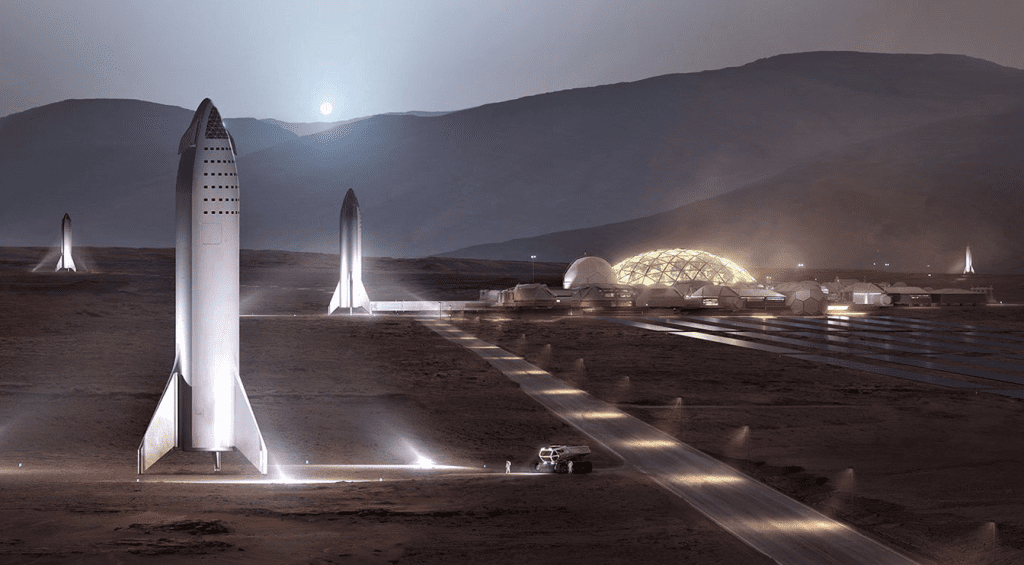This week, SpaceX’s massive Starship rocket once again exploded during testing. While the upper stage did reach space for the first time, the mission ended in failure as both stages were ultimately lost. It was a partial success at best — and a reminder that SpaceX still has a long way to go before Starship can fulfill its ultimate goal: carrying humans to Mars.
- A History of Unrealistic Timelines
- 2026: An Uncrewed Mars Flight? Maybe
- Why a Human Mars Mission by 2028 Is Unrealistic
- 1. Mars Landings Are Incredibly Difficult
- 2. Life Support Challenges
- 3. Return Mission: Not Yet Possible
- The Biggest Problem: Human Health
- Flashy Promises vs. Practical Engineering
- Final Thoughts
Despite the setback, SpaceX CEO Elon Musk doubled down on bold claims. In a presentation shared on May 29, Musk reiterated his vision of sending “millions of people” to Mars to build a “self-sustaining civilization.” He claimed a Starship could launch to Mars as early as 2026, followed by a crewed mission by 2028 or early 2029.

In an interview on CBS Sunday Morning, Musk elaborated:
“If we’re lucky, we’ve probably got about a 50% chance of sending ships from Earth to Mars at the end of next year. So November, December next year. In about 18 months.”
He also admitted,
“I try to give the 50th percentile. So you should expect half the time I’m wrong.”
A History of Unrealistic Timelines
To Musk’s credit, acknowledging fallibility is refreshing. But let’s look at the track record:
- In 2017, Musk claimed a crewed Mars mission could launch by 2024.
- SpaceX was also supposed to land Starship on the Moon by 2022.
- NASA’s goal of landing astronauts on the Moon by 2024 has also fallen flat.
Time and again, these timelines have proved more aspirational than realistic. Grand announcements generate headlines and attention — whether or not they come true is a secondary concern.
2026: An Uncrewed Mars Flight? Maybe
An uncrewed Mars mission in 2026 is not entirely out of the question. SpaceX has demonstrated extraordinary progress with projects like:
- The reusable Falcon 9 rocket
- The Crew Dragon capsule, and
- The Starlink satellite network
But sending a robotic spacecraft to Mars is vastly different from safely delivering humans. And this is where the optimism falls apart.
Why a Human Mars Mission by 2028 Is Unrealistic
Even if Starship launches to Mars in 2026, it won’t carry people. Here’s why:
1. Mars Landings Are Incredibly Difficult
- Landing anything on Mars is hard due to its thin atmosphere.
- Landing heavy equipment or habitats for humans is even harder.
- Safety standards for human passengers raise the bar significantly.
2. Life Support Challenges
- A Mars habitat must generate breathable air and clean water.
- Food must be grown in toxic soil — or sent in massive quantities from Earth.
- Habitats need insulation from extreme temperatures and Martian dust.
3. Return Mission: Not Yet Possible
- No spacecraft has ever launched from Mars back to Earth.
- A return rocket would need to be launched, fueled, and operated from Mars — an engineering feat that’s still science fiction.
The Biggest Problem: Human Health
Experts agree: radiation is the dealbreaker.
- Mars has no magnetic field to shield humans from space radiation.
- Exposure during the journey and on the surface poses serious cancer risks.
- We currently have no portable radiation shielding suitable for astronauts.
Add to that:
- Muscle and bone degradation during long space flights
- Psychological strain of isolation and confinement
- Limited medical options in case of emergency
These are not minor inconveniences — they’re life-threatening unknowns.
Flashy Promises vs. Practical Engineering
In SpaceX’s latest presentation, the company talked of “building cities on Mars” using “the world’s most powerful and capable rocket.” It highlighted that the next Mars launch window opens in late 2026 — referring to a Hohmann transfer orbit, which occurs every 26 months.
But just because the orbit lines up, doesn’t mean we’re ready to send people. There’s no indication that the numerous technical, physiological, and logistical hurdles can be solved in time for a crewed Mars mission within the next 10 years.
Final Thoughts
SpaceX’s ambition is admirable. Human exploration beyond Earth is a noble and necessary goal. But space doesn’t care about ambition — it only responds to precision, preparation, and time.
Grand visions are important. But without the technology, infrastructure, and risk management to back them up, a 2028 human Mars mission is not a plan. It’s science fiction.
Also Read : OnePlus Buds 4 Review: Affordable ANC That Delivers, Especially for Bass Lovers

